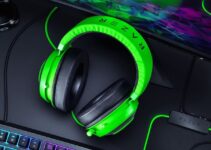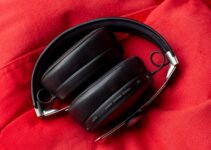If your Skullcandy headphones keep disconnecting and you’re looking for a fix, then you’re in the right place.
Skullcandy headphones are popular among gamers and music lovers due to their durability and high-quality sound. They provide an immersive audio experience, making them a top choice for enjoying games and music. However, some users face issues like frequent disconnections.
In this article, we’ve explained the common causes behind Skullcandy headphones disconnecting and provided the fixes to apply.

Why Skullcandy Headphones Disconnect
1. Bluetooth Interference
- In most cases, other devices like smartphones, Wi-Fi routers, or wireless gadgets can interfere with the Bluetooth connection of your headphones.
- Physical obstacles, such as walls or furniture, can also weaken the Bluetooth signal, leading to frequent disconnections.
2. Low Battery
- If your Skullcandy headphones have a low battery, they may disconnect frequently.
- Insufficient power can cause an unstable connection, resulting in interruptions.
3. Firmware Issues
- Outdated or faulty firmware is one of the most popular reasons behind disconnection problems.
- Firmware is like the software that controls your headphones’ functions, and if it’s not up to date or has bugs, it can cause connectivity issues.
4. Connection Range:
Bluetooth technology has a limited range, and going beyond this range can cause your Skullcandy headphones to disconnect.
How to Fix Skullcandy Headphones Disconnecting
1. Minimize Bluetooth Interference
- Keep other Bluetooth devices away from your headphones or turn them off when not in use.
- Place your audio source device closer to your headphones to reduce signal blockage from physical objects.
2. Charge the Headphones
- Before using your Skullcandy headphones, ensure they have enough battery power.
- Connect them to a power source using the provided charging cable and let them charge completely.
3. Update Firmware
- Ensure that you have the updated firmware, you can always take a look at the Skullcandy website to check for firmware updates.
- Follow the provided instructions to update the firmware of your headphones. Newer versions often fix connectivity issues.
4. Maintain Optimal Range
- Stay within the recommended Bluetooth range specified by the manufacturer.
- Avoid moving too far away from the audio source, especially if there are physical barriers that could weaken the signal.
How to Properly Connect Skullcandy Headphones to Different Devices
To prevent connectivity issues, you should know how to properly connect your Skullcandy headphones to your preferred device. In this guide, we have provided the step-by-step process of connecting Skullcandy headphones to various devices.
Connecting Skullcandy Headphones to a Smartphone or Tablet
- Turn on your Skullcandy headphones by pressing and holding the power button until you see the indicator light or hear the power-on tone.
- On your smartphone or tablet, navigate to the settings menu and find the Bluetooth option.
- Turn on Bluetooth and wait for your device to detect available devices.
- In the list of detected devices, locate your Skullcandy headphones. The name usually includes “Skullcandy”.
- Tap on the name of your Skullcandy headphones to initiate the pairing process.
- Once paired, you will hear a confirmation tone or see an on-screen message indicating a successful connection. Your Skullcandy headphones are now ready to use with your smartphone or tablet.
Connecting Skullcandy Headphones to a Computer or Laptop
- Power on your Skullcandy headphones.
- On your computer or laptop, access the system settings or control panel.
- Get to the Bluetooth settings or devices section.
- Turn on Bluetooth and allow your computer to search for available devices.
- Find your Skullcandy headphones in the list of available devices and click on their name to begin the pairing process.
- Once the pairing is complete, you will receive a notification or see an on-screen message confirming the connection. Your Skullcandy headphones are now connected to your computer or laptop.
Connecting Skullcandy Headphones to a Gaming Console
- Turn on your gaming console (e.g., PlayStation, Xbox, Nintendo Switch).
- On the console’s main menu, go to the settings or preferences section.
- Look for the Bluetooth or wireless devices option.
- Activate Bluetooth and allow the console to search for available devices.
- Put your Skullcandy headphones in pairing mode.
- Once your headphones appear in the list of detected devices, select them to establish the connection.
- You may need to follow additional on-screen instructions or enter a passcode to complete the pairing process.
- After successful pairing, you will receive an on-screen confirmation or hear an audio cue indicating that your Skullcandy headphones are connected to the gaming console.
Note: Some gaming consoles may require the use of a separate Bluetooth adapter if they do not have built-in Bluetooth capabilities.
Connecting Skullcandy Headphones to a Television
- Ensure that your television has Bluetooth functionality. Check the TV’s manual or settings menu to confirm this.
- Power on your Skullcandy headphones.
- On your TV, navigate to the settings menu and find the Bluetooth or audio settings.
- Activate Bluetooth and allow your television to search for nearby devices.
- Put your Skullcandy headphones in pairing mode. Consult the user manual for specific instructions on how to do this.
- Once your headphones are discoverable, select them from the list of available devices on your TV.
- Complete the pairing process by following any additional on-screen prompts or entering a passcode if required.
- Once paired, your Skullcandy headphones will be connected to your television.






![One Side of Beats Headphones Not Working [FIXED] One Side of Beats Headphones Not Working [FIXED]](https://audiojust.com/wp-content/uploads/2023/05/one-side-of-beats-headphones-not-working-211x150.jpg)

